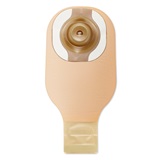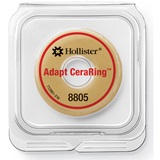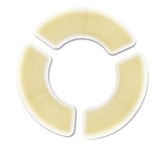5 Tips for Living Well With Convexity
Convex ostomy skin barriers may help you achieve a good seal around your stoma and prevent leakage, but it’s important to keep certain things in mind when using them.

Follow these guidelines to use convexity correctly and take good care of your body.
By Erin Testerman Mitra, RN-BSN, CWOCN
Your body is a good body.
That’s one of the first things I tell patients who have stomas. Not only is your body good, but you have a tremendous opportunity to take good care of it by learning what it needs and how to use ostomy products to your advantage.
For most of my patients – whether they are right out of surgery or have had a stoma for years – I find that using convexity can help them achieve their goals of achieving a good ostomy pouch fit and preventing leakage. A convex barrier pushes down on the peristomal skin, opens or flattens skin folds, and helps the stoma protrude more. In my experience, these barriers can help increase pouching system wear time, tend to be more flexible, and are suitable for a range of body types.
It’s important, however, to keep the following tips in mind when using convexity:
1. One Size Does Not Fit All
All bodies are unique. And because they change over time, it's important to periodically re-evaluate whether your ostomy products are meeting your current needs. For example, how your body looks immediately after surgery will be very different than how it looks a couple of weeks after surgery. Either way, it’s safe to consider a convex skin barrier at any point.
As your body starts to heal, the swelling and firmness caused by surgery will start to go away and your natural contours will show, changing the appearance of your stoma. As time goes on, things like weight changes, becoming pregnant, or exercising can change how a stoma presents – which can change the type of ostomy supplies you need for a good fit.
2. Keep it Simple
It’s important to make sure that your ostomy pouching system is placed correctly and securely. However, sometimes people will overdo it, thinking they need to add things that will help keep their ostomy bag in place. Using too many ostomy accessories can add unnecessary complexity to your stoma care.
The goal should be to use as few ostomy accessories as possible, while still ensuring a secure pouch fit and maintaining skin health. If you’re using a convex skin barrier, selecting a barrier that is infused with ceramide can help you achieve this. Ceramide is a natural component in human skin that helps prevent water loss that can lead to skin dryness and damage. Because ceramide-infused skin barriers are designed to adhere to the skin while protecting its natural moisture, they can help simplify your stoma care routine.
3. Make a Pouchable Surface
Before you put on your convex skin barrier, it’s important to have a “pouchable” skin surface. Lift your belly upwards above the stoma and hold the skin with one hand while attaching the skin barrier to the skin around the stoma (peristomal skin). This can help flatten any skin folds and ensure that you have a secure barrier fit, which helps prevent leakage and skin issues. Gently press down on the skin barrier around the stoma.
4. Seek Help When You Need It
While ostomy surgery can place significant stress and strain on your body, bruising and discomfort should not be a normal part of your long-term stoma journey. Often, these are signs that your ostomy products are not right for you.
If you find that you’re dealing with these kinds of issues or any discomfort, be sure to visit your healthcare provider for an assessment. In addition, Hollister Secure StartSM services can be a great resource to answer your questions or help you find the right ostomy supplies.
5. Take Care of the Rest of Your Body
Sometimes it’s easy to think only about your stoma and how to properly care for it. But stoma care means entire body care. It’s important to develop a healthy eating routine, so your gastrointestinal (GI) tract functions properly and you can avoid any food-related issues – such as blockages or obstructions. Getting the mental health support you need is also critical, to help you embrace life with your stoma and care for your body. In addition, finding new ways to exercise can be very beneficial.
Understanding and following these five guidelines can not only help you use convexity correctly, but also remind you that your body is a good body, and that you have the right to live well with an ostomy. And no matter what health journey you’re on, living well should be your first priority.
Financial Disclosure: Erin Testerman Mitra received compensation from Hollister Incorporated for her contribution to this article.
Erin Testerman Mitra, RN-BSN, CWOCN is a certified Wound Ostomy Continence (WOC) nurse at New York-Presbyterian/Columbia University Irving Medical Center. She is active in community outreach programs, promotes positive ostomy awareness as an ostomy advocate, and is the Metro NY WOCN Affiliate President. Erin is completing a Master of Science in Nursing at Columbia University and aims to improve pre-operative communication, education, and patient experience in the surgical setting.
- 4 Shares
- 23 Recommended






 Call Us
Call Us  Email Us
Email Us  Join Us!
Join Us!  Sign Up
Sign Up 